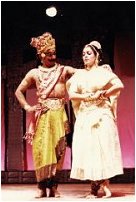 |
 |
| A Report
Innovation within tradition
– lec-dem by V P Dhananjayan
Natyarangam presented a lecture demonstration by V P Dhananjayan on March 21, 2004. Dhananjayan spoke about innovating within tradition, about how the creative choreography of his earlier works was based on what is already described in the Naatya Shaastra. |
| As always,
any attempt to describe innovation must first address the question, what
is tradition? Dhananjayan described tradition as a flowing river where
the water itself is continuously replenished but the river remains as an
abiding entity. Therefore, innovation and change are always welcome and
necessary and can be created within the banks of tradition. The Naatya
Shaastra describes the "highest civilized form of dance in the world."
Bharatanaatyam, based on the Naatya Shaastra, can be described as the most
developed, civilised and sophisticated dance form in the world with a technique
that is as deep and as vast as an ocean. In describing his early work,
Dhananjayan quoted an American dance critic's comment, "The Dhananjayans
style of Bharatanaatyam seems to be as ancient as Naatya Saastra itself
and as modern as a New Yorker".
Speaking about his guru, Rukmini Devi, he said that she herself had made many changes in the art form then known as Sadir. What is now known as the Kalakshetra tradition was actually path-breaking innovation by Rukmini Devi. Just as she was free to effect changes within the boundaries of the dance form taught to her by her gurus, the Dhananjayans also made small changes in what they had learnt from her. For example, they used the stylized entry and exit movements that she gave to characters in the dance dramas for solo performances as well. They created a combination of an Alarippu, Jateeswaram and Sabdam for an opening item, and called it Naatyanjali. When they first presented it, it was criticized but today having stood the test of time, it is appreciated by rasikas. Moving from tradition to "modern dance", Dhananjayan spoke about how pained he was that the term modern dance inevitably meant something derived from the west, particularly the term body language. What is angika abhinaya, if not body language, he asked. As an example of a theme conveyed solely through the use of the body, he played a video clipping of a scene from an early work, Ramanatakam. Ramanatakam itself was very unusual in many ways. It was the first time that a dance drama theme was presented with simple costumes and the characters were not dressed up to look as Rama or Ravana. This helped the dancers move in and out of theme-based movements as well as character portrayals. The sethubandhanam scene was done with dancers using flowing movements to describe the waves of the ocean. |
| Describing
another early work of his, Sanghamitra, he talked about how with the right
support a dancer is free to work solely on the artistic element of the
dance leaving other considerations like lighting, PR, music, sets to professionals.
The Government of Singapore sponsored a presentation of this Buddhist theme
and here again innovations were many. The use of period costumes which
were researched, the use of angika abhinaya in conjunction with creative
musical elements to describe stupas being built by sculptors, and the creation
of a different pattern of movements, away from the strict tat tai ta ha's
of Bharatanaatyam to a more rounded movement, to suggest the dance of the
court-dancers and Ashoka's palace itself.
Another Buddhist theme Karuna, gave him scope to explore angika abhinaya in a different way. The various seasons were portrayed to instrumental music, including a piece of Western music, Ravel's Bolero, that is similar to our Indian Shankarabharanam. |
 |
| Perhaps
the crowning achievement in terms of innovation was the creation of Jungle
Book in collaboration with the Ohio Ballet Company. Dhananjayan called
it "fusion without confusion." It won the best dance production award in
the Ohio state of America. Here ballet dancers as well as trained Indian
dancers created a seamless blend of Eastern and Western dance forms without
compromising on their integrity. Once again, thanks to proper funding and
a strong support system, the choreographer was free to concentrate on the
work at hand. Heavy, earth grounded movements were danced by the Bharatanaatyam
dancers whereas the airy leaps of gazelles were performed by ballet dancers.
Music, lighting, costumes, stage and public relations management were in
the care of other professionals. The music by Pt. Vijay Raghav Rao was
beautifully composed, and evoked the movements of each animal, the prowling
tiger, and the slithering snake. Dhananjayan paid a complement to Uma Ganesan
of the Cleveland Cultural Alliance for facilitating such a professional
production. The CCA is once again venturing into a massive production -
the Tamizh classic "Silappadikaaram".
The evening
ended with Dhananjayan answering questions from the audience.
Tulsi Badrinath started to learn dance from the age of 8. She is a student of the Dhananjayans. |
 |